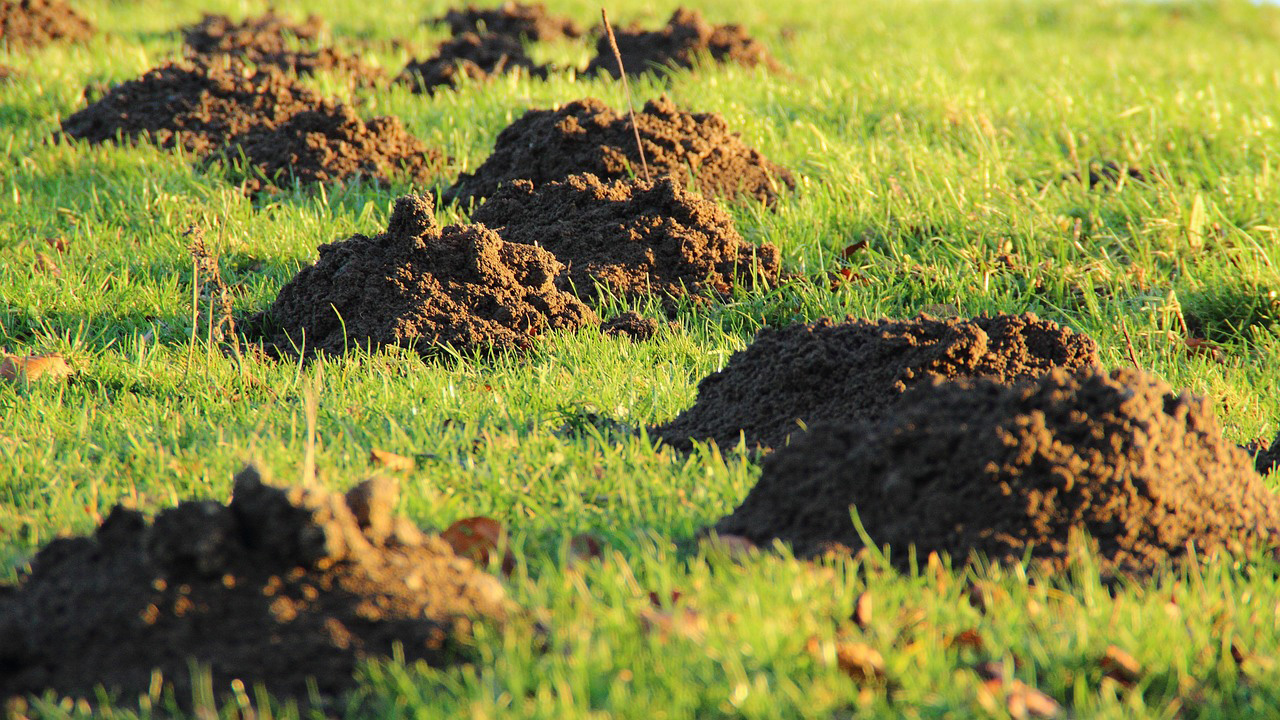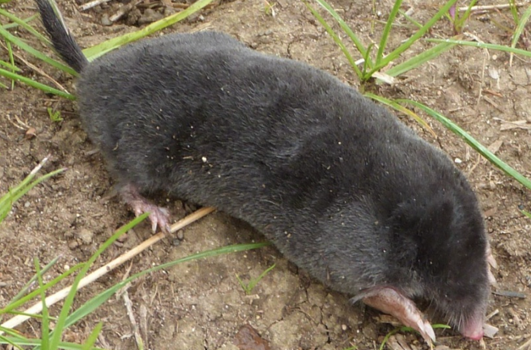
How to Get Rid of Moles in Your Yard and Keep Them Away
December 5, 2024Moles might seem harmless at first glance, but their presence in your yard can quickly turn into a frustrating infestation. These small creatures are proficient diggers, creating intricate tunnel systems that can wreak havoc on lawns and gardens and completely wreck your carefully cultivated property. You may be asking yourself, “What are moles?” and “Why are they a concern?” At Dominion, we have the answers to these questions and more. Read on to learn how to get rid of moles in your yard — and more importantly, how to keep moles out of your yard.
Types of Moles Found in Central Pennsylvania
Moles are small insectivorous mammals that dwell entirely underground. They are expert diggers that consume insects, grubs, and earthworms for sustenance. In Central Pennsylvania, you are likely to encounter three main types of moles:
Eastern Mole (Scalopus aquaticus)
Description: The Eastern Mole is the most common species in Pennsylvania, and the type of mole you are most likely to encounter in our area. It has a robust body with large forefeet adapted for digging and velvety fur ranging from gray to silver.
Habitat: Eastern Moles prefer loose, moist soils where they can easily dig tunnels. They are commonly found in lawns, gardens, fields, and woods.
Star-Nosed Mole (Condylura cristata)
Description: Easily recognizable by its distinctive star-shaped nose, this mole has a sleek, blackish-brown body and is slightly smaller than the Eastern Mole.
Habitat: Typically found in wet areas such as marshes, swamps, and along the edges of streams and ponds, Star-Nosed Moles are excellent swimmers and can even forage underwater.
Hairy-Tailed Mole (Parascalops breweri)
Description: The Hairy-Tailed Mole has dark grey fur with lighter underparts, a pointed nose, and a short, hairy tail.
Habitat: Found in forested and open areas with dry, loose soils, this mole is another proficient digger, creating extensive tunnel systems.
Why a Mole Infestation is Bad
While moles can benefit your yard by aerating the soil and controlling insect populations, a widescale infestation can lead to several problems — most notably, extensive damage to your lawn and garden. Moles often travel underground by means of surface tunnels, which areshallow tunnels just below the surface that disrupt your lawn soil, leading to uneven, bumpy ground. This can make mowing difficult and create tripping hazards.
Moles also create molehills, which are mounds of soil pushed to the surface that can smother grass and plants, creating unsightly patches in your lawn or garden.
Mole tunneling can disturb the roots of grass, flowers, and other plants, causing them to wilt, become stressed, or die, leading to soil erosion, destabilizing the ground. Mole tunnels can also undermine walkways, patios, and the foundations of buildings, causing cracking, sinking, or other structural issue. They can even disrupt underground irrigation lines or drainage systems, causing water leaks.
The presence of ridges, tunnels, and molehills can severely damage and even ruin the appearance of your property while attracting other pests. For example, insects and voles can use the mole tunnels to access plant roots and bulbs, causing additional damage.
Addressing the damage caused by moles can be time-consuming and costly, requiring ground leveling, reseeding grass, and replacing damaged plants or infrastructure.
How to Identify When You Have Moles
Identifying a mole infestation early can help you take necessary actions before extensive damage occurs. Here are some telltale signs:
Raised Ridges and Tunnels
Surface Tunnels: Moles create shallow, raised tunnels just beneath the surface, creating a ridged effect often seen running across lawns.
Appearance: The ridges are usually visible and feel soft or spongy when walked on.
Molehills
Mounds of Soil: Moles push up soil to the surface as they dig deeper tunnels, creating conical mounds called molehills.
Size and Shape: Molehills are typically about 6-8 inches in diameter and vary in height. The soil is usually fine and appears as a pile of loose dirt.
Damaged Grass
Browning or Dying Grass: Raised tunnels can disrupt root systems, leading to areas of dying or browning grass.
Pattern: Damage often appears in irregular patterns following the network of tunnels.
Soft Spots in the Lawn
Uneven Ground: Walking on your lawn, you may notice soft or sinking areas where the ground gives way more than usual, indicating tunnels below.
How to Get Rid of Ground Moles
Controlling and preventing moles from infesting your yard, knowing how to get rid of moles in your garden, or even trying to understand how to kill moles, can be a frustrating challenge. But several effective methods can help reduce or eliminate their presence:
Trapping
Types of Traps: The most effective traps are harpoon, scissor-jaw, and choker loop traps.
Placement: Place traps in active tunnels. To find active tunnels, compress a small section of the tunnel and check it after a day or two. If the tunnel is re-raised, it is active.
Timing: Set traps during the early morning or late evening when moles are most active.
Baiting
Mole Baits: Poison baits that mimic earthworms or grubs are available. Follow the manufacturer’s instructions carefully when using these products.
Safety: Keep bait away from children, pets, and non-target wildlife.
Repellents
Chemical Repellents: Castor oil-based repellents can deter moles. These can be applied in granular or liquid form.
Application: Apply repellents uniformly over the affected area and water them into the soil to increase effectiveness.
Natural Repellents: Planting certain plants, such as marigolds, daffodils, and alliums, may help repel moles.
Physical Barriers
Underground Fencing: Install a barrier of hardware cloth or metal mesh around gardens or specific areas. Bury it 24-30 inches deep and bend the bottom portion outward to prevent moles from burrowing underneath.
Raised Beds: Use raised garden beds with a wire mesh bottom to prevent moles from entering from below.
Soil Management
Reduce Food Sources: Moles feed on grubs, insects, and earthworms. Applying grub control products can help reduce mole food sources.
Soil Compaction: Compacting the soil can make it less attractive to moles. However, this method may not be suitable for all types of lawns and gardens.

Preventing Future Infestations: How To Keep Moles Away
Keeping your lawn well-mowed will reduce cover for moles, and regularly aerating your lawn will improve drainage and discourage mole activity. If moles are suspected, you should inspect your lawn and garden for signs of mole activity and follow the tips above on how to get rid of moles in your yard, fast. Early detection can help prevent extensive damage.
While moles play an important role in the ecosystem by aerating the soil and controlling insect populations, their presence in residential lawns and gardens can cause significant problems. By identifying the signs of a mole infestation early and employing effective control methods, you can keep moles away from your property. But if your mole problem has become a major infestation, it may be time to call an experienced exterminator.
Professional Mole Extermination
If you’ve tried various strategies without success or if your mole infestation is widespread or persistent, consider hiring a professional pest control service like Dominion. We know how to get rid of gophers and moles, and we have the knowledge, experience, and specialized tools to safely and effectively eliminate moles and other pests from your property.
We Get Rid of Moles Naturally
At Dominion Pest Control, we specialize in lawn pest control. Our team of professional exterminators will conduct a thorough inspection to identify the extent of the infestation and determine the best course of action. We have developed a very effective wildlife repelling service that makes use of safe, natural products that we use to rid your yard of moles for good. Using all-natural products proven to discourage nuisance wildlife, Dominion can help to keep these critters on the move. These products are entirely non-toxic and completely safe when used according to the label. Through our use of targeted treatments and natural preventative measures, we can help you ensure that your yard and garden remain mole-free.
Get In Touch
At Dominion Pest Control, our dedicated team is committed to providing exceptional service and ensuring your home or business is free from pests. We encourage you to get in touch with us if you have any questions or need further assistance. You can contact us here to learn more about how we can help you achieve a pest-free environment.
We serve Lancaster County (Lititz, Lancaster city, Manheim, Ephrata, Strasburg, etc), York County (Dallastown, Red Lion, York city, Hellam, etc), Lebanon, and Hershey. Here’s a map of our location and service area:



